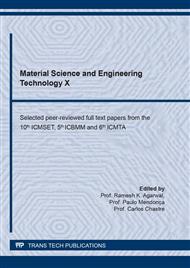p.297
p.303
p.309
p.315
p.323
p.331
p.338
p.345
p.352
Influence of Eggshell Powder as Cementitious Blends in Cement Mortar
Abstract:
Solid waste management is one of the challenging issues faced by the developing countries. The developing countries find it very critical to manage the disposal of waste generation. India ranks 3rd in the production of egg, generating about 3.8 billion kilograms annually. This growth in the production of larger rate is mainly due to the hike in domestic consumption. This could lead to larger generation of solid waste. To overcome these issues, eggshell could be effective incorporated into concrete production as cementitious blends. This paper investigates the suitability of eggshell powder as partial substitute to cement. The material characterization techniques such as SEM were used to investigate the feasibility of using eggshell powder. The study was conducted by producing cement mortars in the ratio of 1:3 parts of cement. Then the cement was partially replaced by eggshell powder at 5%, 10%, 15%, 20% by its weight. The fresh property was assessed using the flow table test, while the hardened property was determined using the compressive strength of the cement mortar at 7, and 28 days. From the test results, 10% eggshell powder when utilized in mortar gives optimum compressive strength.
Info:
Periodical:
Pages:
323-330
Citation:
Online since:
February 2022
Authors:
Keywords:
Price:
Сopyright:
© 2022 Trans Tech Publications Ltd. All Rights Reserved
Share:
Citation:


